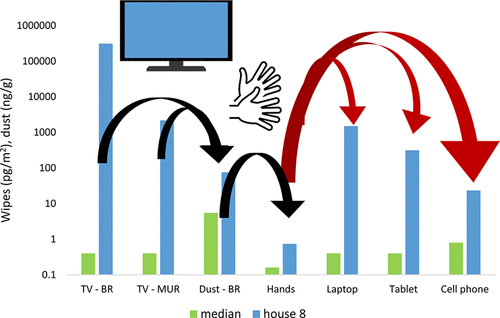当前位置:
X-MOL 学术
›
Environ. Sci. Technol. Lett.
›
论文详情
Our official English website, www.x-mol.net, welcomes your feedback! (Note: you will need to create a separate account there.)
Are We Exposed to Halogenated Flame Retardants from both Primary and Secondary Sources?
Environmental Science & Technology Letters ( IF 10.9 ) Pub Date : 2020-06-08 , DOI: 10.1021/acs.estlett.0c00268 Congqiao Yang 1 , Simona Rozárka Jílková 2 , Lisa Melymuk 2 , Shelley Anne Harris 3, 4 , Liisa M. Jantunen 1, 5 , Jessica Pertili 6 , Louise Winn 6 , Miriam L. Diamond 1, 3
Environmental Science & Technology Letters ( IF 10.9 ) Pub Date : 2020-06-08 , DOI: 10.1021/acs.estlett.0c00268 Congqiao Yang 1 , Simona Rozárka Jílková 2 , Lisa Melymuk 2 , Shelley Anne Harris 3, 4 , Liisa M. Jantunen 1, 5 , Jessica Pertili 6 , Louise Winn 6 , Miriam L. Diamond 1, 3
Affiliation

|
Halogenated flame retardants (HFRs) were measured in air, floor dust, and surface wipes of electronic devices (e-devices) and hands of participants in 51 Canadian homes to assess the relationship between HFR levels in these matrices and to identify major sources and exposure pathways. Hand-held e-devices had significantly higher concentrations of all HFRs than non-hand-held devices, with the exceptions being decabromodiphenyl ethane (DBDPE) and decabromodiphenyl ether (BDE-209). HFR concentrations on hands were correlated with levels in dust and hand-held e-devices, with the strongest correlations being seen for BDE-47 and -99, 2-ethylhexyl-2,3,4,5-tetrabromobenzoate (EH-TBB), and bis(3-ethylhexyl) tetrabromophthalate (BEH-TEBP). It is highly unlikely that hand-held devices sampled in 2015 had intentionally added BDE-47 and -99 that were regulated in 2008 in Canada. We hypothesize that hands transferred these chemicals from older products, which act as primary sources, to hand-held devices, which then can act as secondary sources of exposure. This study also found evidence for TVs as a primary source of DBDPE and BDE-209 for dust, hand-held devices, and hands. We suggest that an outdated, overly stringent flammability standard, developed in the 1970s to protect against fires from “instant-on” cathode ray tube TVs, led to elevated levels of these HFRs indoors. Although the standard for TV enclosures has been updated recently, the legacy of the outdated standard persists.
中文翻译:

我们是否接触过来自主要和次要来源的卤代阻燃剂?
在空气,地板灰尘和电子设备(电子设备)的表面擦拭物中以及加拿大51个家庭的参与者的手中测量了卤代阻燃剂(HFR),以评估这些基质中HFR含量之间的关系,并确定主要来源和暴露途径。手持式电子设备中所有HFR的浓度均明显高于非手持式设备,但十溴二苯乙烷(DBDPE)和十溴二苯醚(BDE-209)除外。手上的HFR浓度与灰尘和手持式电子设备中的浓度相关,其中BDE-47和-99、2-乙基己基-2,3,4,5-四溴苯甲酸酯(EH-TBB)的相关性最强,以及双(3-乙基己基)四溴邻苯二甲酸酯(BEH-TEBP)。2015年采样的手持设备不太可能故意添加加拿大在2008年规定的BDE-47和-99。我们假设手将这些化学物质从用作主要来源的较旧产品转移到了手持设备中,然后这些手持设备可以用作暴露的次要来源。这项研究还发现有证据表明电视是灰尘,手持设备和手的主要DBDPE和BDE-209来源。我们建议,1970年代开发的过时,过于严格的可燃性标准旨在防止“即时”阴极射线管电视着火,从而导致室内这些HFR的水平升高。尽管电视柜的标准最近已更新,但过时的标准仍然存在。用作手持设备的主要来源,然后可以用作暴露的次要来源。这项研究还发现有证据表明电视是灰尘,手持设备和手的主要DBDPE和BDE-209来源。我们建议,1970年代开发的过时,过于严格的可燃性标准旨在防止“即时”阴极射线管电视着火,从而导致室内这些HFR的水平升高。尽管电视柜的标准最近已更新,但过时的标准仍然存在。用作手持设备的主要来源,然后可以用作暴露的次要来源。这项研究还发现有证据表明电视是灰尘,手持设备和手的主要DBDPE和BDE-209来源。我们建议,1970年代开发的过时,过于严格的可燃性标准旨在防止“即时”阴极射线管电视着火,从而导致室内这些HFR的水平升高。尽管电视柜的标准最近已更新,但过时的标准仍然存在。1970年代开发的用于防止“即时”阴极射线管电视着火的火灾导致室内这些HFR的水平升高。尽管电视柜的标准最近已更新,但过时的标准仍然存在。1970年代开发的用于防止“即时”阴极射线管电视着火的火灾导致室内这些HFR的水平升高。尽管电视柜的标准最近已更新,但过时的标准仍然存在。
更新日期:2020-08-11
中文翻译:

我们是否接触过来自主要和次要来源的卤代阻燃剂?
在空气,地板灰尘和电子设备(电子设备)的表面擦拭物中以及加拿大51个家庭的参与者的手中测量了卤代阻燃剂(HFR),以评估这些基质中HFR含量之间的关系,并确定主要来源和暴露途径。手持式电子设备中所有HFR的浓度均明显高于非手持式设备,但十溴二苯乙烷(DBDPE)和十溴二苯醚(BDE-209)除外。手上的HFR浓度与灰尘和手持式电子设备中的浓度相关,其中BDE-47和-99、2-乙基己基-2,3,4,5-四溴苯甲酸酯(EH-TBB)的相关性最强,以及双(3-乙基己基)四溴邻苯二甲酸酯(BEH-TEBP)。2015年采样的手持设备不太可能故意添加加拿大在2008年规定的BDE-47和-99。我们假设手将这些化学物质从用作主要来源的较旧产品转移到了手持设备中,然后这些手持设备可以用作暴露的次要来源。这项研究还发现有证据表明电视是灰尘,手持设备和手的主要DBDPE和BDE-209来源。我们建议,1970年代开发的过时,过于严格的可燃性标准旨在防止“即时”阴极射线管电视着火,从而导致室内这些HFR的水平升高。尽管电视柜的标准最近已更新,但过时的标准仍然存在。用作手持设备的主要来源,然后可以用作暴露的次要来源。这项研究还发现有证据表明电视是灰尘,手持设备和手的主要DBDPE和BDE-209来源。我们建议,1970年代开发的过时,过于严格的可燃性标准旨在防止“即时”阴极射线管电视着火,从而导致室内这些HFR的水平升高。尽管电视柜的标准最近已更新,但过时的标准仍然存在。用作手持设备的主要来源,然后可以用作暴露的次要来源。这项研究还发现有证据表明电视是灰尘,手持设备和手的主要DBDPE和BDE-209来源。我们建议,1970年代开发的过时,过于严格的可燃性标准旨在防止“即时”阴极射线管电视着火,从而导致室内这些HFR的水平升高。尽管电视柜的标准最近已更新,但过时的标准仍然存在。1970年代开发的用于防止“即时”阴极射线管电视着火的火灾导致室内这些HFR的水平升高。尽管电视柜的标准最近已更新,但过时的标准仍然存在。1970年代开发的用于防止“即时”阴极射线管电视着火的火灾导致室内这些HFR的水平升高。尽管电视柜的标准最近已更新,但过时的标准仍然存在。


























 京公网安备 11010802027423号
京公网安备 11010802027423号